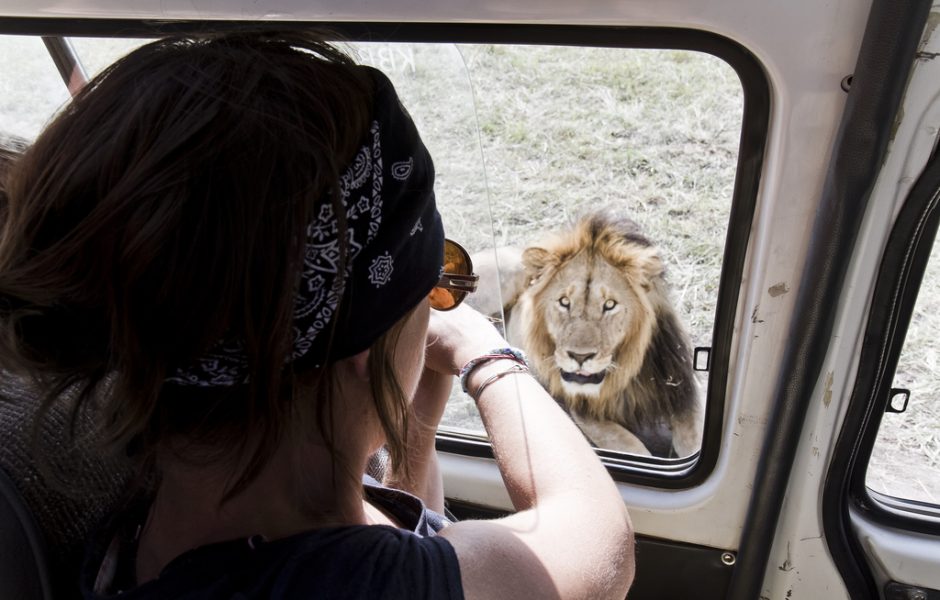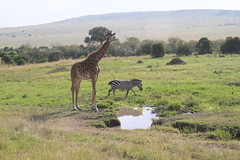How to track a lion on safari without becoming prey


A hungry lion
There’s nothing like being stared at like you’re a piece of meat.
The lion less than five feet away from us licked its lipped, noting the open window in the safari vehicle, and the tender human arm belonging to Erin Huber just inside.
“Hurry up and close the window,” our driver Cyrus says. The seven women in the vehicle jumped into action and within moments, we were safe (?).
We came across the king of the jungle just after he had brought down a water buffalo, which lay in a grassy field 50 feet away — its body ripped open by the hungry lion. The rest of the pride was nowhere to be seen. Perhaps, the buffalo stumbled upon the lion’s resting mid-day resting place and became easy prey. Either way, the lion was clearly exhausting, panting and breathing heavily. The vultures had just taken notice and began to gather in the trees near the fresh kill. In moments, the lion might have to chase them off, but for the moment, he’s happy to have some shade.
The Kenyan safari, which cost us $525 each, had already paid off by the time we came across this scene in the Masai Mara Reserve. Of the big five game animals — lions, cheetahs, leopards, elephants and rhinoceros — we had already spotted everything but the rhino. And by the end of the entire trip, we had seen those, too, plus a lot more.
July is one of the best time for game tracking in the Kenyan wildlife park. Over the next month or so, millions of wildebeest make their annual migration, traveling en masse from the Serengeti in Tanzania, across the Mara River and into Kenya. It becomes a veritable feast for the carnivorous creatures that depend on the wildebeest as a food source, so danger lurks at every turn. And it’s good on the safari companies’ pocket books as well. Hundreds of white vans with pop-up tops travel the dirt roads of the reserve during this time period, too. Each one carries eight passengers.
 As soon as a sighting takes place, the drivers talk to each other and pretty soon, we’re racing across the savannah to hopefully get to see the animal in question. By the time we arrive, you would think it were a parking lot. The animals are surrounded by vans with the occupants sticking out of the top with cameras to their faces.
As soon as a sighting takes place, the drivers talk to each other and pretty soon, we’re racing across the savannah to hopefully get to see the animal in question. By the time we arrive, you would think it were a parking lot. The animals are surrounded by vans with the occupants sticking out of the top with cameras to their faces.
I chuckle to myself, because the whole thing is utterly ridiculous. But I love it. This in Africa for real. These animals aren’t on an Animal Planet program or behind bars at a zoo. The latter is part of the challenge and excitement of being on safari.
We arrive at a tree where three leopards had been sleeping only to watch them hop down and run for cover as we were still approaching. All the drivers tried to chase the spotted cats through the brush, but are thwarted by vegetation, and other vehicles. One driver hits our van trying to back up away from a tree trunk impeding his way. For all the carelessness, our front bumper has only a small dent and we go on our way again.
Not every moment was as exhilarating, mostly because we spent most of our time sitting or standing in the van. As much as I would have liked to take a hike, the reserve doesn’t allow people to so much as step on the grass briefly — for good reason, I suppose. So, for four days, we bobbed back and forth in the closed quarters of the van. I have bruises all over my body to show for it.
Most of our time was spent driving around past herds of wildebeest, buffalo, gazelle and zebras, which became old hat after awhile. We longed to see an elephant lumbering across our path, giraffe heads poking up above the dense tree cover, and leopards cheetahs and lions in pursuit of their prey. And when those moments came, we were in awe.
We just hoped we wouldn’t become dinner.

Write a Reply or Comment